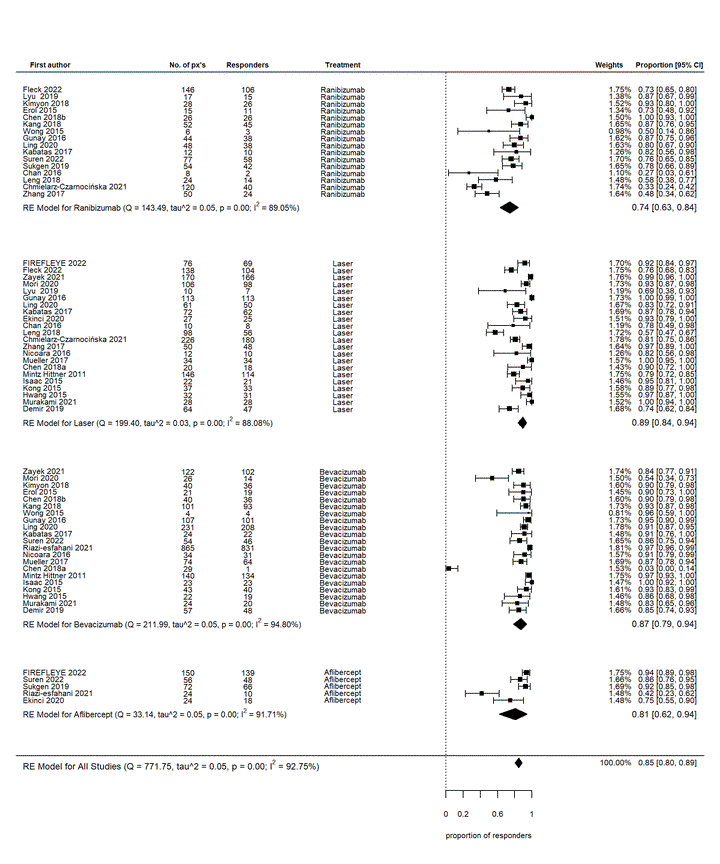A Network Meta-Analysis of Retreatment Rates following Bevacizumab, Ranibizumab, Aflibercept and Laser for Retinopathy of Prematurity

Abstract
Topic: To compare bevacizumab, ranibizumab, aflibercept, and laser treatment as primary therapies for retinopathy of prematurity (ROP) in terms of retreatment rate.
Clinical relevance: Anti-VEGF agents are increasingly used as primary treatment for ROP and may provide superior outcomes compared with laser in posterior disease. Head-to-head comparisons between different anti-VEGFs are lacking.
Methods: We searched CENTRAL, Embase, MEDLINE, and CINAHL databases for randomized controlled trials and nonrandomized comparative studies that had been reported as of March 2022. We included studies that used bevacizumab, ranibizumab, aflibercept or laser for ROP with comparable cohorts and treatment criteria. Studies were evaluated by the Grading of Recommendations, Assessment, Development and Evaluation framework, and those with biased case selection, nonrandomized case-control, or lack of control group were excluded. Frequentist meta-analyses of proportions determined the absolute primary retreatment rate of each modality and Bayesian network meta-analyses compared pairs of treatments in type 1 and Zone I ROP.
Results: In all, 30 studies (4686 eyes) were included in the network meta-analyses. For type 1 ROP, single-treatment success rates (i.e., likelihood of needing no further treatment) were 89.3% (95% confidence interval [CI]: 83.8%-93.8%; n = 1552) for laser, 87.0% (95% CI: 78.6%-93.8%; n = 2081) for bevacizumab, 80.7% (95% CI: 62.0%-94.4%; n = 326) for aflibercept, and 74.0% (95% CI: 62.7%-84.1%; n = 727) for ranibizumab. Bayesian network meta-analysis indicates that laser treatment is associated with a significant 62% (95% credible interval [CrI]: 16%-83%) reduction in retreatment risk compared with ranibizumab, while no significant difference was found among other pairwise comparisons. The mean +- standard error of the mean times to secondary treatment following primary aflibercept (12.96 +- 0.47 weeks) and bevacizumab (11.36 +- 0.54 weeks) therapy were significantly longer than that for primary ranibizumab (9.29 +- 0.43weeks) therapy (P = 7 x 10^-7 and P = 9 x 10^-3, respectively). For Zone I ROP, single-treatment success rates were 91.2% (95% CI: 83.6-96.9; n = 231) for bevacizumab, 78.3% (95% CI: 61.4-91.9; n = 100) for ranibizumab, and 65.9% (95% CI: 41.4-87.2; n = 158) for laser treatment. In this case, Bayesian network meta-analysis suggests that primary bevacizumab is associated with a significant 67% (95% CrI:10%-90%) reduction in retreatment risk compared with laser treatment.
Conclusions: Laser was associated with a lower rate of retreatment than ranibizumab in type 1 ROP (Zones I and II combined), while bevacizumab was associated with a lower rate of retreatment than laser in Zone I ROP. Aflibercept and bevacizumab demonstrate longer duration of action than ranibizumab for ROP.
Download article PDF.
Full R code for network meta-analysis —–> github page